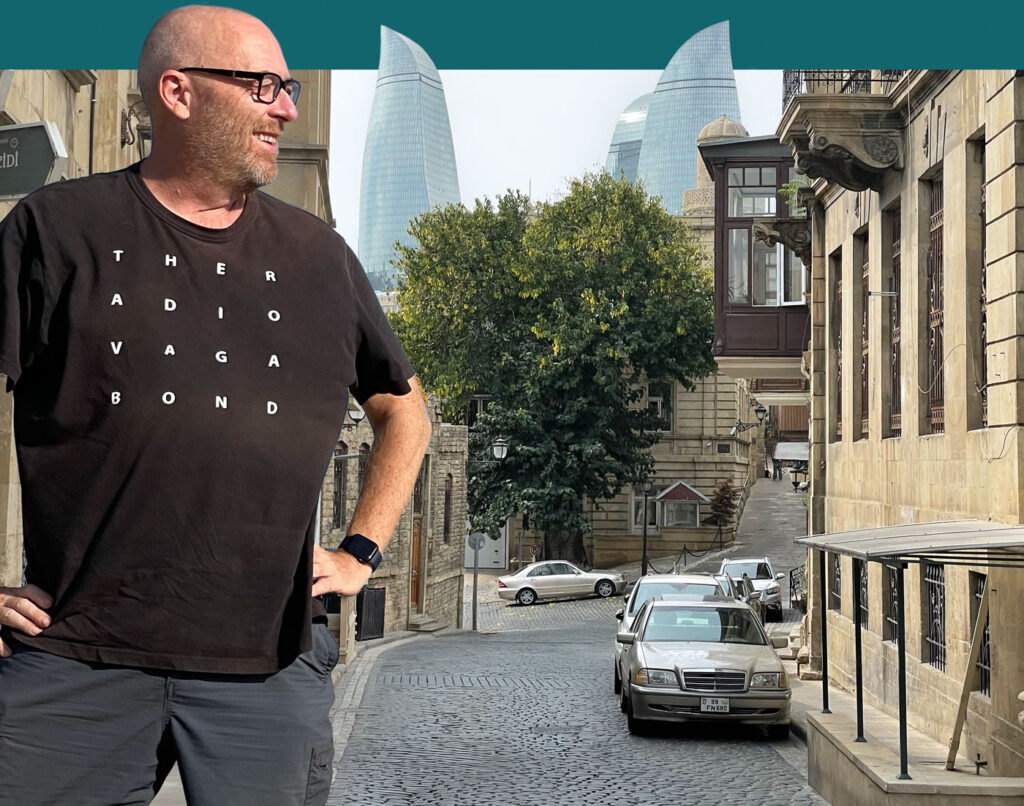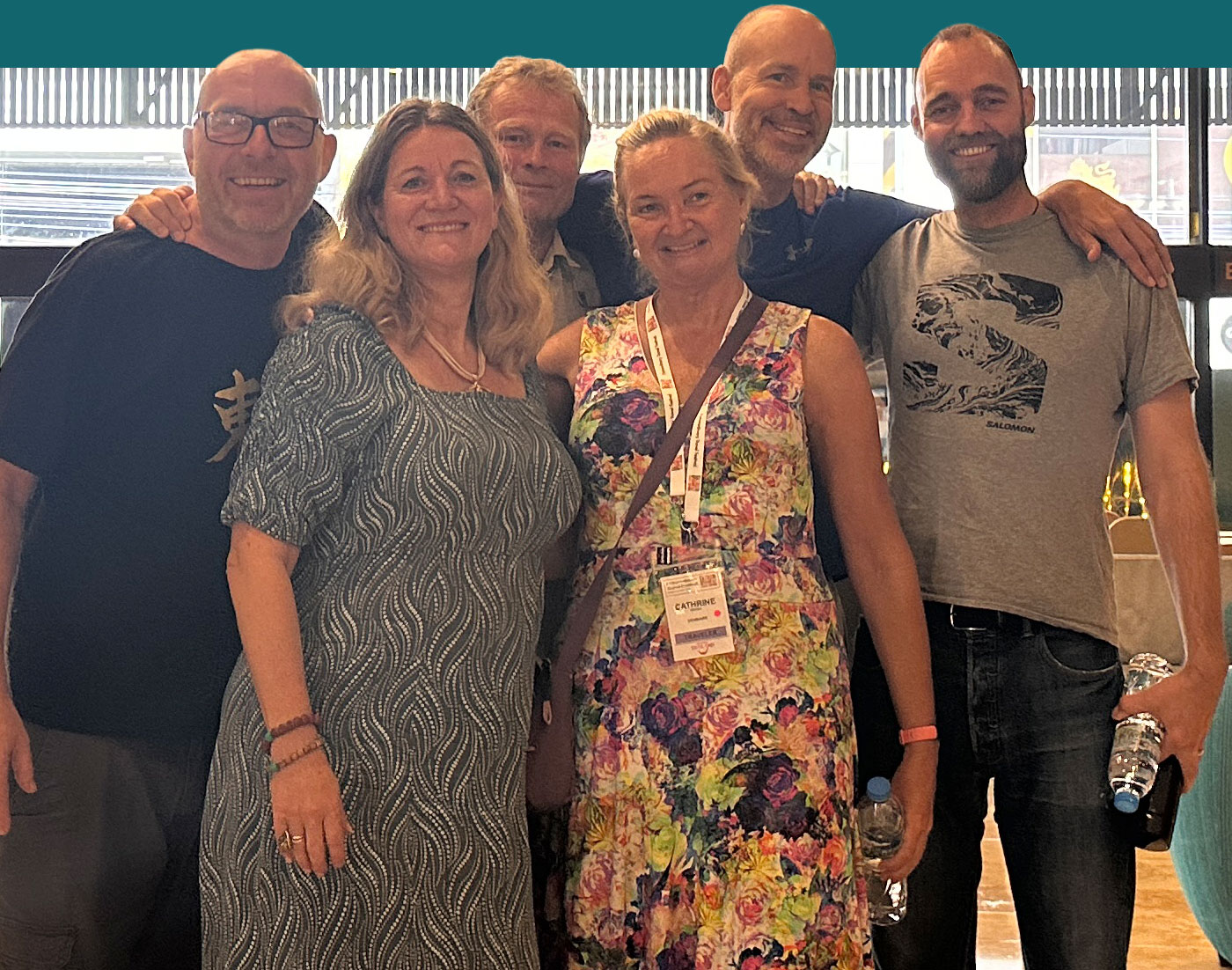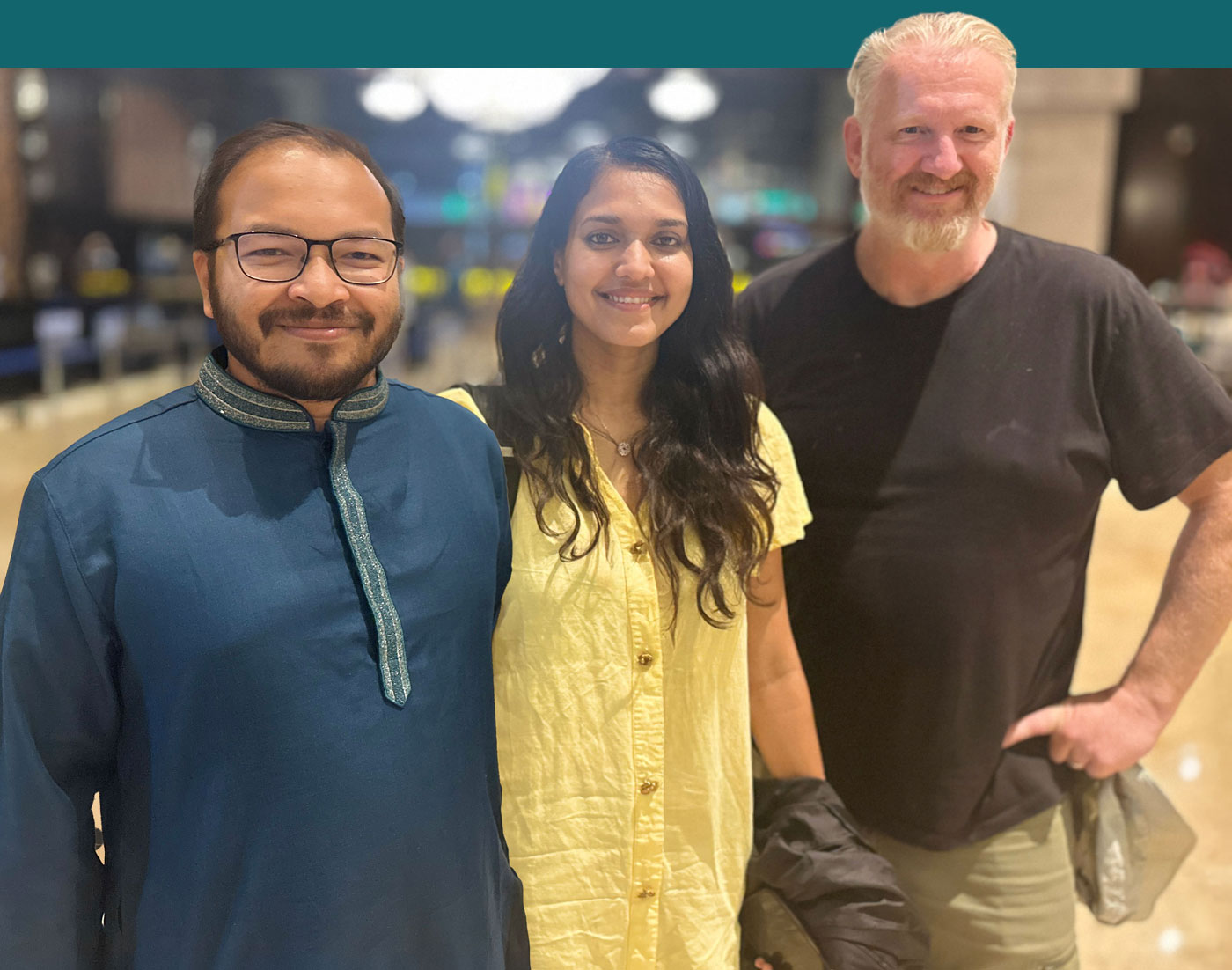Exploring Baku, Azerbaijan:
A City of Contrast and Culture
Welcome to The Radio Vagabond! In this episode, we dive into one of the most fascinating cities in the world: Baku, Azerbaijan. This city is where ancient history meets futuristic architecture, and we’re taking you along as we explore both the old walled city and the ultra-modern skyline. Along the way, we’ll meet some friendly locals, discover hidden gems, and hit the road for a journey across the beautiful landscapes of Azerbaijan.
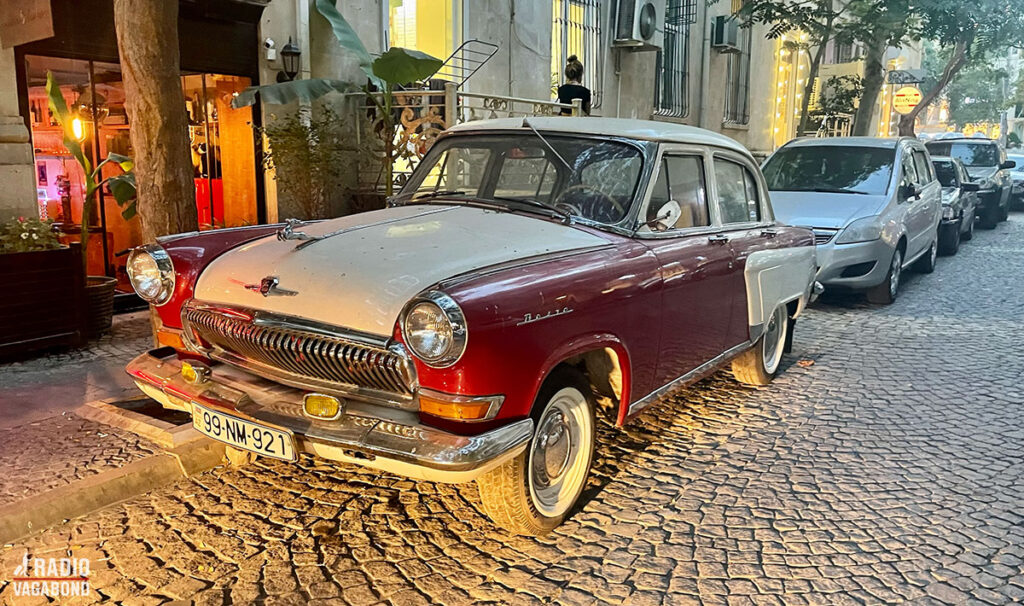
No Room for Us
It’s 3:30 a.m., and after a long day of traveling, I arrive at the hotel, ready to crash. But, of course, there’s a hiccup – my reservation didn’t go through. The night receptionist does his best to help, but I end up having to wait until the morning to speak to the manager. As a traveler, you quickly learn that things don’t always go according to plan. Staying calm and flexible is key – after all, these little bumps along the road often make for the best stories!

Travelling With my American Friend
On this trip, I’m (again) travelling with my trusted travel companion, Cynthia Rignanese aka “Cynthia Globe” – an extreme traveller from Florida who’s been to more countries than me. We met in Florida and since then we’ve done quite a few trips together. You might remember our road trip through Saudi Arabia and our adventures in Australia. To make sure we were at the same hotel, she asked me to book a room for her too. But none of the two rooms were showing up at his computer.
Just as I thought we were going to sleep in the lobby, he managed to get us a room for what’s left of the night. Then we could speak to the manager the next day.
BAKU: Paris meets Dubai
After just three hours of sleep, I hit the streets of Baku with my travel companion, Cynthia. Right away, you notice the blend of old and new that defines this city. On one side, you have the ancient walled city, where the cobblestone streets and centuries-old buildings make it feel like a step back in time. Then, look up, and you’ll see futuristic skyscrapers, like the Flame Towers, lighting up the skyline.
This fusion of Paris-like charm and Dubai-like modernity works surprisingly well. You can stroll through streets filled with Persian and Ottoman influences, and just around the corner, you’re in the middle of a buzzing, cosmopolitan city filled with high-end shops and cafes. It’s a place where history and modern luxury sit side by side.
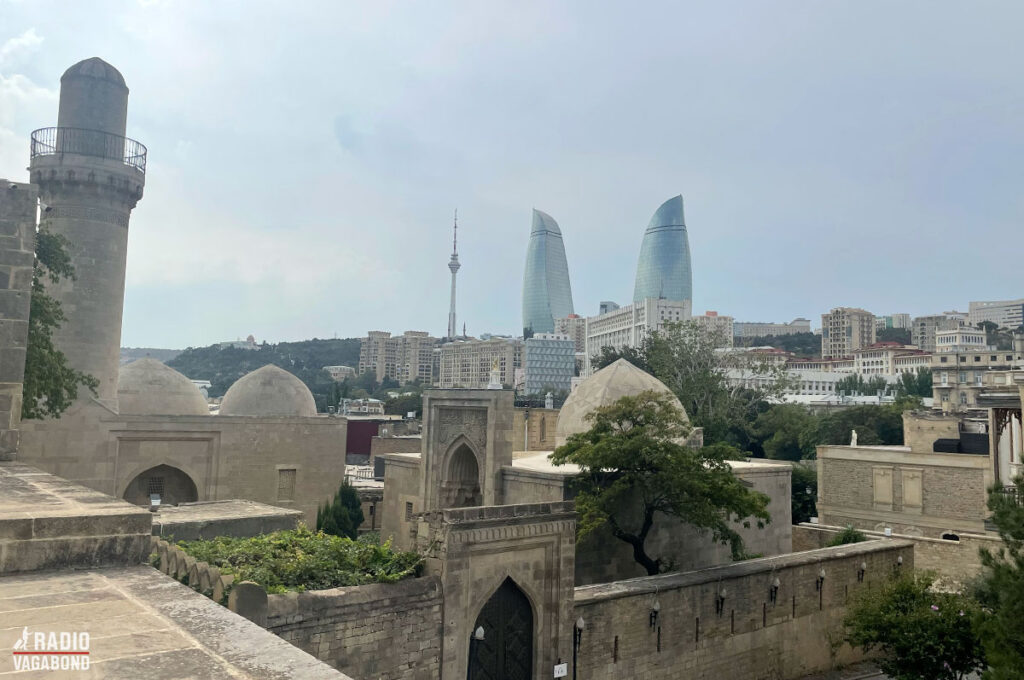
Walking Tour of The Old Town
One of the best ways to explore Baku is by taking a free walking tour, and that’s exactly what we did. Our guide, Gani, is an encyclopedia of knowledge about Baku. The Old Town, or Icheri Sheher, is the heart of the city’s history. As you walk through its narrow streets, you can feel the weight of centuries of stories. It’s beautifully preserved, with ancient palaces, mosques, and inns, many of which have been restored. And while it’s a tourist attraction, people still live here, giving the Old Town a vibrant, lived-in feel.
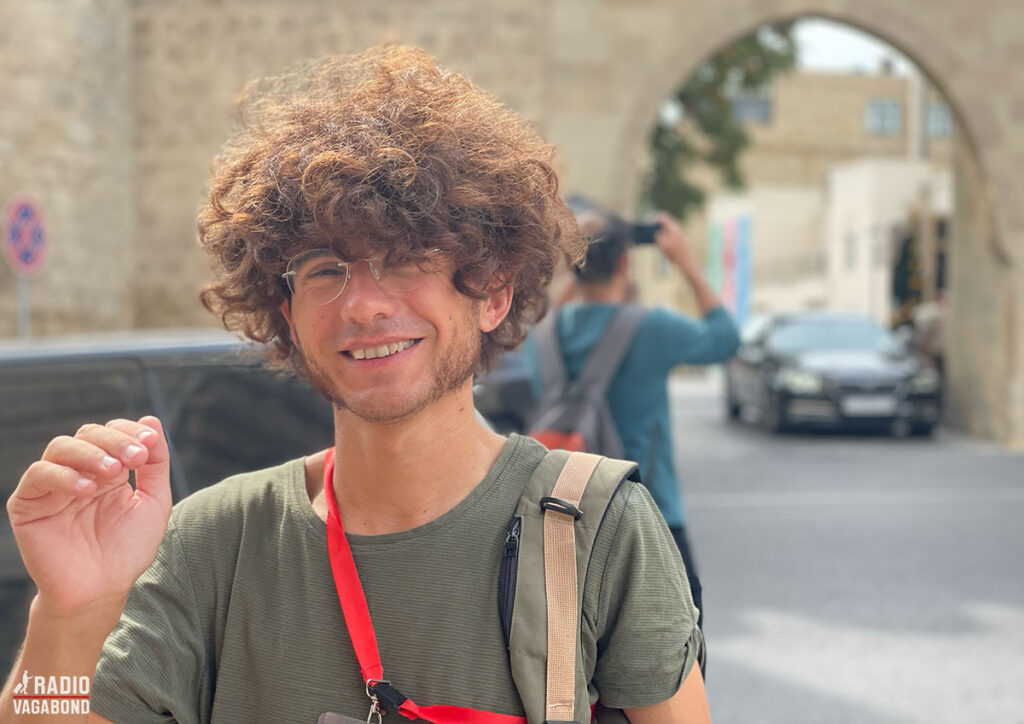
A LOOK IN THE HISTORY BOOK
The Old City of Baku, also known as Icheri Sheher (Inner City), has a rich history dating back centuries. The exact date of the Old City’s founding is uncertain, but archaeologists believe that human settlement in the area could date back as far back as the Bronze Age – 3300 to 1200 BC. But the city really began to take shape in the 12th century, some structures like the Maiden Tower may date back even earlier.
In the 12th century, Baku became the capital of the Shirvan state under the Shirvan-shah Dynasty that ruled the region for centuries. They built many of the landmarks we see today, including parts of the fortress walls and towers.
During the medieval period, Baku flourished as an important stop on trade routes as a strategic location on the Silk Road.
In 1806, Baku was conquered by the Russian Empire. This marked a new chapter in the city’s history, as it began to expand beyond the old walls.
Throughout its history, the Old City has been a melting pot of cultures, with influences from Persian, Arabic, Turkish, and later Russian civilizations shaping its architecture and culture. Today, it stands as a living museum, showcasing over 1000 years of Azerbaijani history and culture.
Old Town’s Defence System
The old town had a strong defence system with two canals – or “moats” outside the wall. Local legends say that one was filled with water and the other with oil. The idea of an oil-filled moat was a defensive strategy to set invaders on fire by shooting an arrow with fire on them. As Gani explains:
“Intruders had to go through water and fire”.
The Old Town of Baku is the heart of the city’s history. When you walk through its narrow, cobblestone streets, you immediately feel the weight of centuries that have shaped this place.
What makes this place so special is how well-preserved it is. The ancient palaces, mosques, and old inns for travellers are still here, many of them beautifully restored. The Old Town isn’t just a museum, though. People still live here, and you’ll see residents hanging laundry from balconies and chatting on the streets. It’s not just for tourists; it’s part of the daily rhythm of Baku. This mix of history and everyday life makes The Old Town feel alive.
The Mysterious Maiden Tower
One of the most iconic landmarks in Baku’s Old Town is the Maiden Tower. Its origin and purpose remain a mystery. Some say it dates back to the 7th century, while others argue it was built in the 12th century. Was it a defensive structure, a watchtower, or perhaps a Zoroastrian fire temple? Nobody knows for sure.
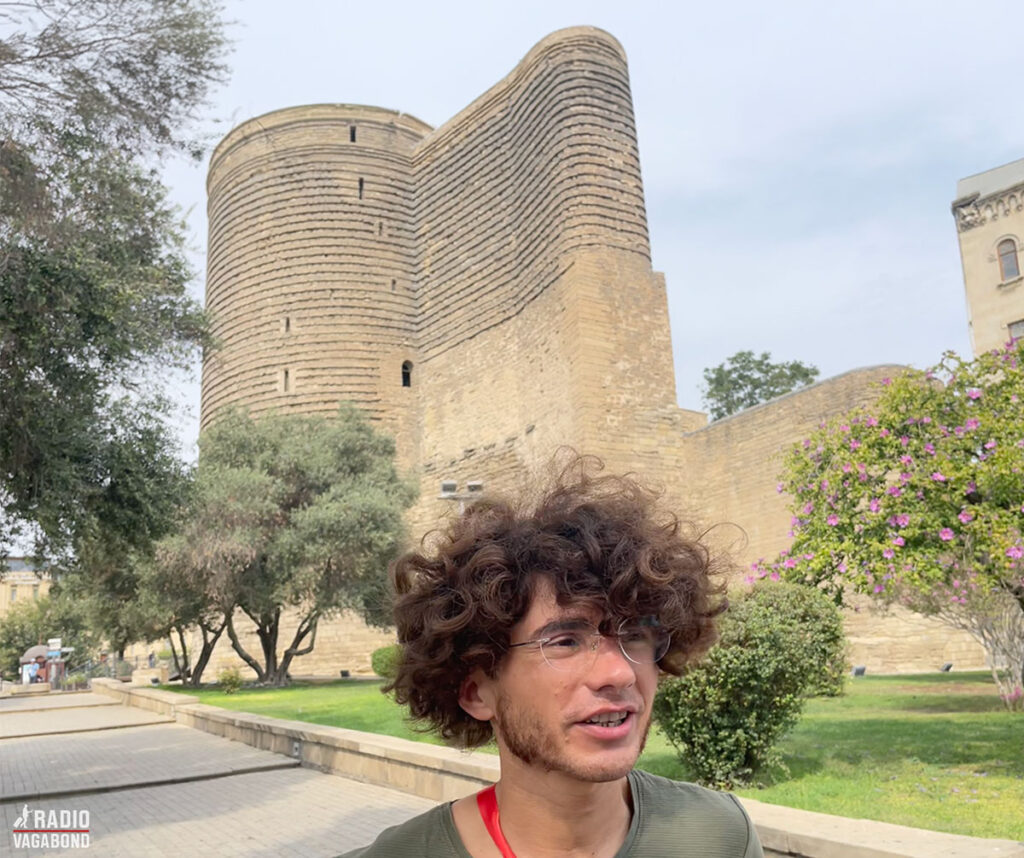
There’s also a tragic legend behind its name. According to the story, a king who wanted a son ordered his newborn daughter to be killed. Her nanny saved her, raising her in secret. Years later, the king, unaware that she was his daughter, wanted to marry her. The horrified maiden asked the king to first build her a tall tower, hoping to delay the marriage. When the tower was completed, she threw herself from the top in despair. This tragic tale adds to the mystique of the Maiden Tower.
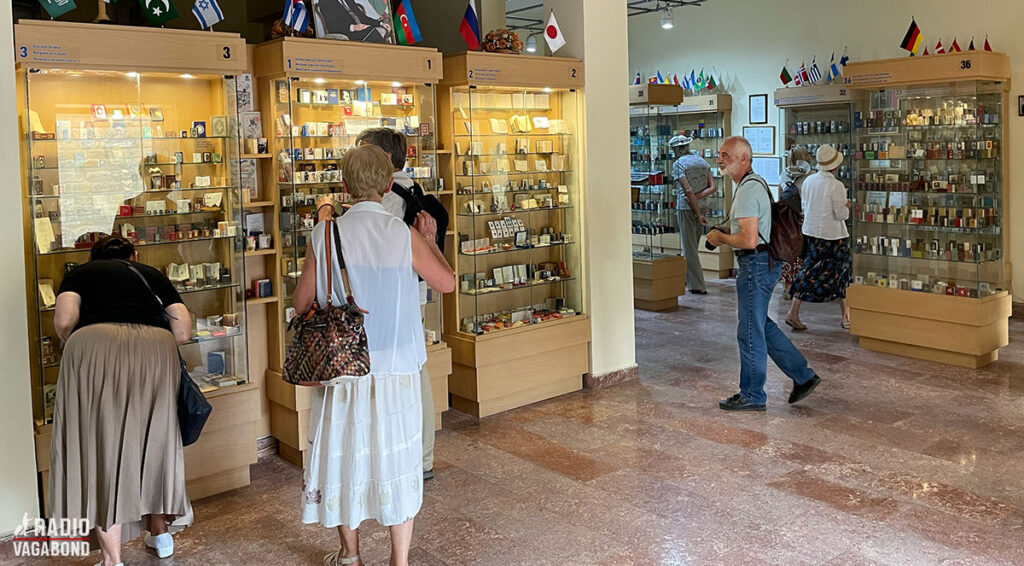
A Compact Adventure
Exploring the Old Town doesn’t take long – you can walk from one end to the other in about 20 minutes – but every corner reveals something new. One unique spot is the Miniature Book Museum, which holds a collection of over 6,500 miniature books from around the world.
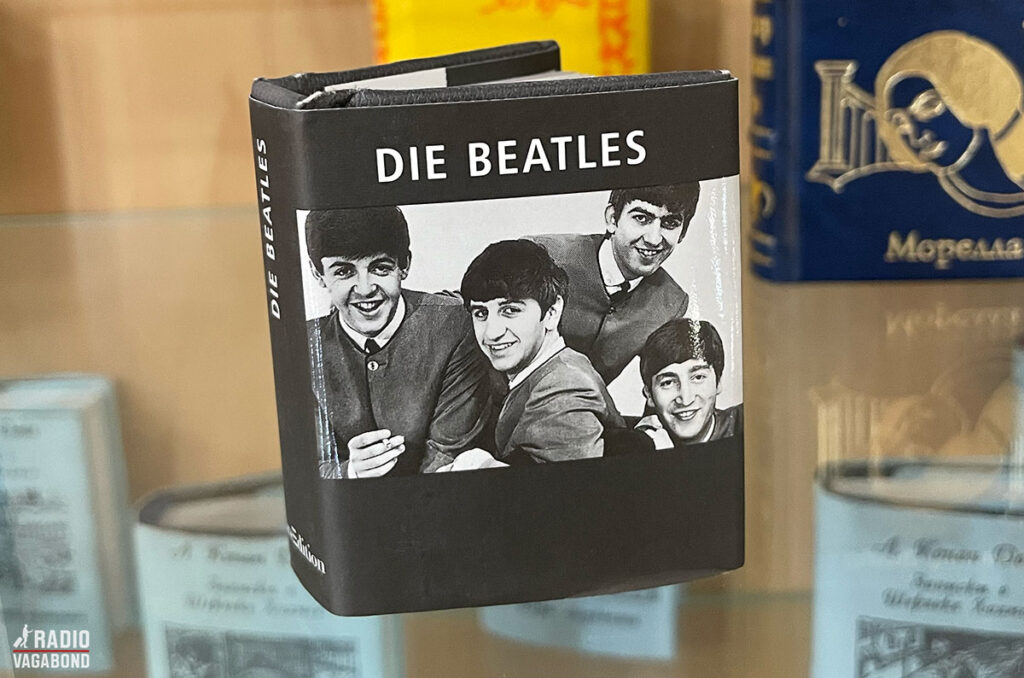
While you can’t buy the books it’s not a shop, but a museum and an interesting place to visit if you’re interested in rare and miniature editions, with some of the books dating back several centuries. The collection is the Guinness Record Holder for largest in the world.
FACTS ABOUT AZERBAIJAN
Location
Azerbaijan is located in the Caucasus region at the crossroads of Eastern Europe and Western Asia. It borders the Caspian Sea to the east, Russia to the north, Georgia to the northwest, Armenia to the west, and Iran to the south. It also has a small border of just 17 kilometers (about 10.5 miles) with Turkey.
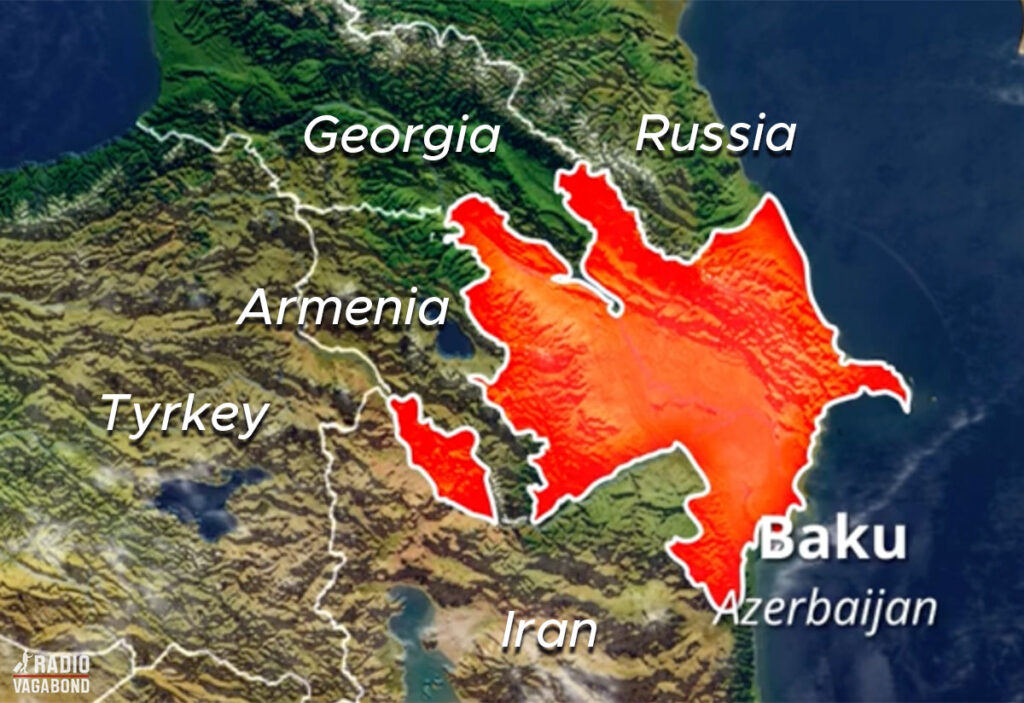
Size and Population
Approximately 86,600 square kilometers (33,400 square miles), slightly smaller than Portugal. The population is around 10.1 million people. The capital of Azerbaijan is Baku, with a population of 2.3 million people. That makes it the largest city in the country and the entire Caucasus region.
Official Languages
The official language is Azerbaijani (Azeri) but as a part of the former Soviet Union, Russian is also widely spoken. You can mostly get by in English here – especially in major cities and among younger generations, but it’s still moderate compared to Western standards.
Democracy and Elections
Azerbaijan is often seen as a country with limited democracy. While they do hold elections, many international organizations have pointed out that these elections aren’t truly free and fair, and there are concerns about political repression and the lack of real freedom for opposition groups to participate openly in politics.
Economy and Living Standards
Azerbaijan is considered an upper-middle-income country, driven by its oil and natural gas industries. It’s often referred to as the “Land of Fire”. This nickname stems from the country’s rich history with natural gas and oil. For centuries, Azerbaijan has been known for its fire mountains and eternal flames.
Baku is considered one of the first places in the world where oil was drilled commercially. The oil industry in Baku has a long history, dating back to 1846, when the first mechanically drilled oil well was established near the city
Religion
Islam is the main religion in Azerbaijan, with about 97% of the population identifying as Muslim. But, compared to many other Muslim-majority countries, religion plays a smaller role in daily life.
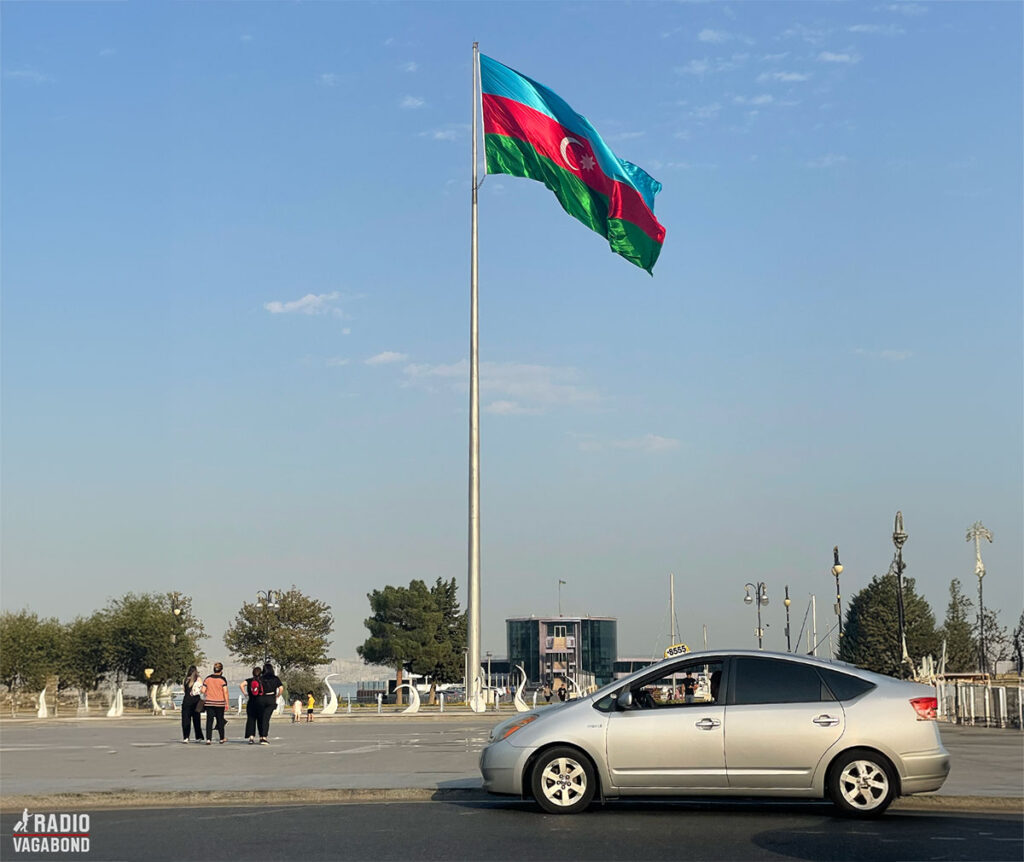
The Flag
The Azerbaijani flag consists of three horizontal stripes of blue (top), red (middle), and green (bottom). A white crescent and an eight-pointed star are centred on the red stripe. The blue represents Turkic heritage, the red symbolizes progress and modernization, and the green stands for Islam.
Local Food
The national dish is Plov, a saffron-flavoured rice meal with various meats or vegetables.
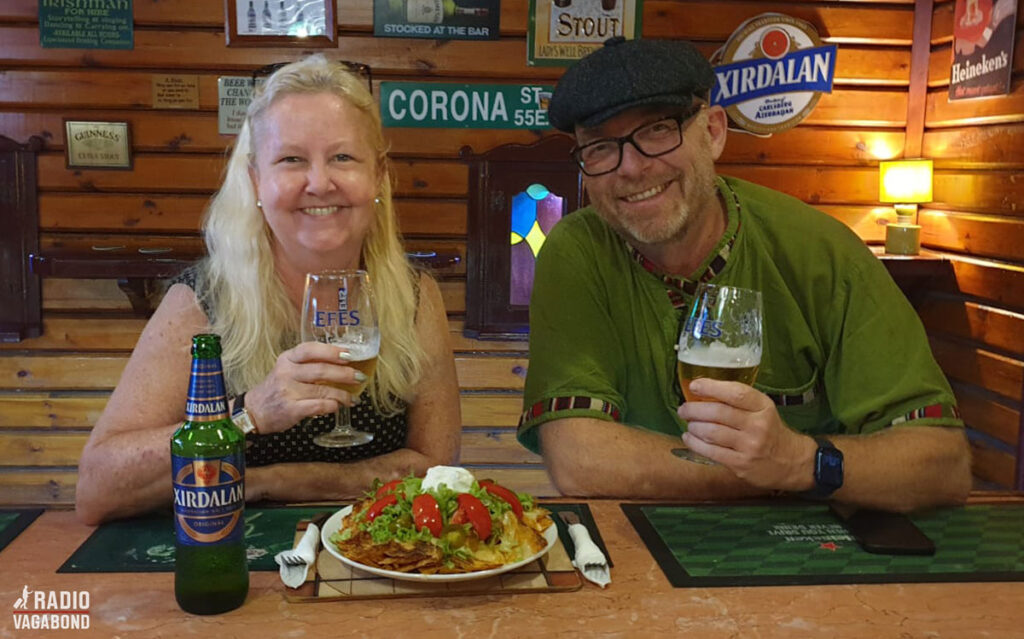
Local Beer
One of the most popular local beers is Xirdalan Beer, named after a town near Baku. It’s a pale lager and is widely consumed across the country.
Famous Proverbs
“Not knowing is not a sin, refusing to learn is” that talks about the value of education and truth in Azerbaijani culture. And “The rope of lies is short” – that suggests that dishonesty doesn’t last long, and the truth will come out sooner or later.
FRIENDS AND ENEMIES
Azerbaijan’s relationships with its neighbors are shaped by both historical ties and modern geopolitics. Turkey is often considered Azerbaijan’s closest ally. The two countries share a deep cultural and linguistic bond, with Azerbaijan often referring to Turkey as its “big brother.” The relationship is strong, but as Gani mentioned, Azerbaijan sometimes feels that Turkey needs to show a bit more respect to maintain this “BFF” status.
Georgia is another important ally, serving as Azerbaijan’s bridge to the West. The two countries have a stable, mutually beneficial relationship, particularly when it comes to trade and energy. Gani described this connection as a “Catholic marriage,” emphasizing the steady, long-term nature of their partnership.
The relationship with Russia is more complicated. Historically, Russia has treated Azerbaijan as part of its sphere of influence, viewing it as somewhat of a “backyard” where they throw their trash. While Russia plays a significant role in the region, Azerbaijan is cautious about being too close to Moscow, especially given Russia’s history of interference in neighboring countries’ affairs.
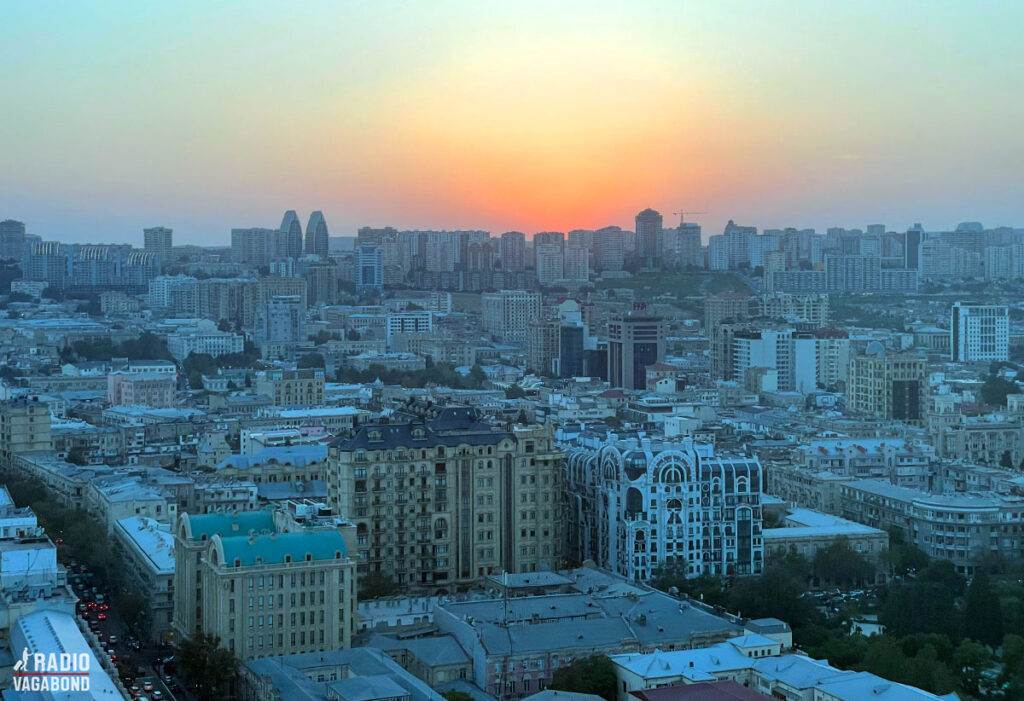
Iran, on the other hand, is a tricky neighbor. A large number of ethnic Azerbaijanis live in northern Iran – potentially up to 30 million – which has complicated relations. Iran doesn’t always acknowledge Azerbaijan’s right to be independent and has been known to tease them symbolically, such as flipping their flag upside down to put Islam (represented by the green stripe) at the top. This dynamic creates tension, as Iran is wary of Azerbaijan’s growing ties with the West.
Their mortal enemy, Armenia
Finally, there’s Armenia, Azerbaijan’s “mortal enemy.” The long-standing conflict over Nagorno-Karabakh remains unresolved. This region, internationally recognized as part of Azerbaijan, has a majority Armenian population, leading to decades of tension. After the collapse of the Soviet Union, a war broke out in the early 1990s, with Armenia gaining control of the area. In 2020, Azerbaijan regained much of the territory during a renewed conflict, but despite ceasefires, the situation is still tense, and the conflict is far from over.
These complex relationships with neighboring countries reflect Azerbaijan’s strategic position at the crossroads of Europe and Asia, with deep historical roots and modern political challenges.
More to come from Azerbaijan
In the next episode, we’ll explore the futuristic architecture of Baku before heading out into the countryside to discover ancient rock carvings and mud volcanoes. From scenic drives to unexpected adventures (including a trip to the hospital), there’s plenty more to come. Stay tuned!
My name is Palle Bo, and I gotta keep moving. See you.
I WOULD LIKE TO HEAR FROM YOU!
Please tell me where are you and what are you doing as you listen to this episode? You can either send me an email on listener@theradiovagabond.com, go to TheRadioVagabond.com/Contact or send me a voice message by clicking on the banner.

Either way, I would love to hear from you. It’s so nice to know who’s on the other end of this.
SPONSOR
A special thank you to my sponsor, Hotels25.com, who always provide me with the best, most affordable accommodation wherever I am in the world.
Hotels25 scans for prices on the biggest and best travel sites (like Booking.com, Hotels.com, Agoda and Expedia) in seconds. It finds deals from across the web and put them in one place. Then you just compare your options for the same hotel, apartment, hostel or home and choose where you book.
When you book with Hotels25, you get access to 5,000,000 hotel deals. And it’s “best price guaranteed.”
PRODUCED BY RADIOGURU
The Radio Vagabond is produced by RadioGuru. Reach out if you need help with your podcast.

